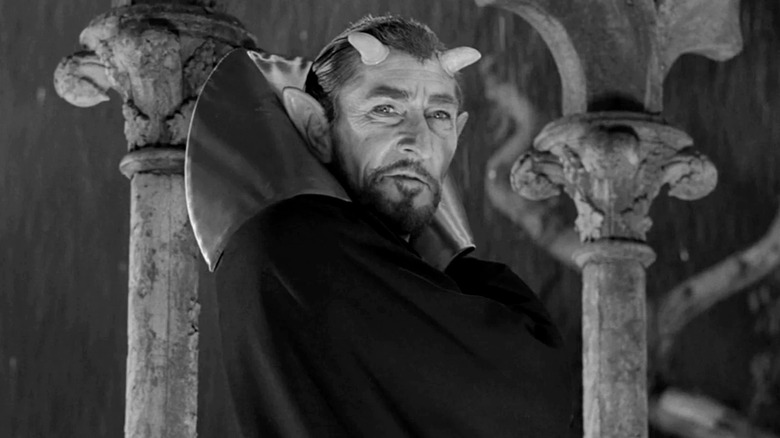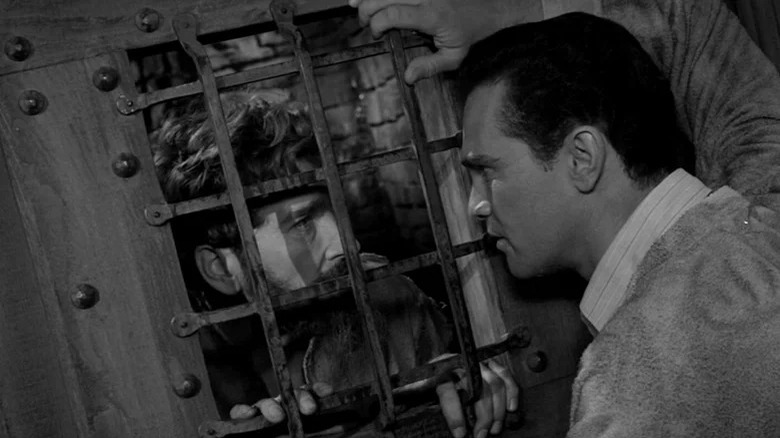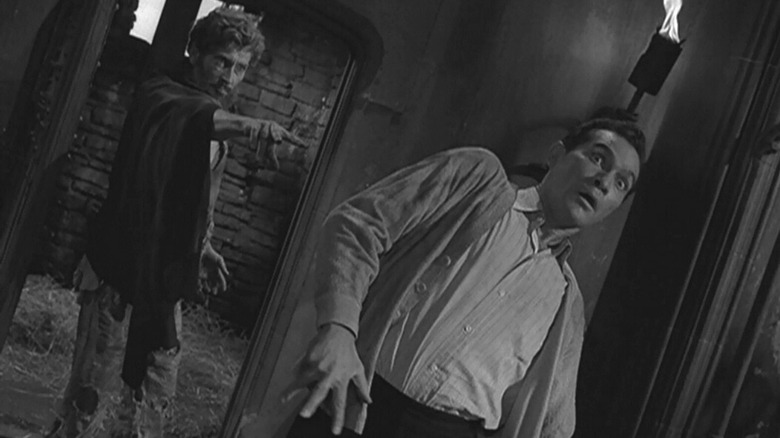Why The Howling Man Is The Twilight Zone's Scariest Episode
When a story enters "The Twilight Zone," it can traverse genres ranging from fantasy to science-fiction to horror. My favorite episode of the series is one that fits mostly into the last category: season 2 episode 5, "The Howling Man," which takes a classic "don't judge a book by its cover" premise into creepy (and theological) directions.
Five years after World War 1, American traveler David Ellington (H.M. Wynant) is lost in a storm and stumbles on a monastery. The men — clad in robes, carrying staves, and using only candles for light — turn away Ellington's request for shelter. While leaving he hears a horrible howling and finds the source is a ragged man (Robin Hughes) who is locked in a cell. Brother Jerome (John Carradine) warns that this prisoner is Satan himself, imprisoned by his brotherhood to prevent evil on the scale of the Great War. A disbelieving Ellington frees the Howling Man ... and sees him transform into the Prince of Darkness once he's free. Oops!
"The Howling Man" was directed by Douglas Heyes, who delivered a spectacular one-two punch with this and the following episode, "Eye of the Beholder." Both are tales about how appearance does not correlate to morality, but "Eye of the Beholder" has a wider scope: it depicts a whole society where pig-faces are handsome and beauty (by our standards) is disgusting. "The Howling Man" is a more isolated story, and scarier for it.
The Howling Man is The Twilight Zone meets Universal Horror
The horror of "The Howling Man" is baked into not just its premise but the setting in which it unfolds. The gothic castle where the Brotherhood of Truth resides looks right out of the 1930s black-and-white horror films by Universal. It's easy to imagine that in that castle, Ellington could've stumbled on Dracula or Doctor Frankenstein instead. "The Twilight Zone" was shot in black-and-white for practical reasons (color in television was impractical and expensive), but that was often to the show's benefit as black-and-white coloring adds atmosphere. That's particularly true in "The Howling Man," where the lack of color recalls those old horror films.
Episode writer Charles Beaumont was reportedly disappointed by Heyes' insistence on showing the Devil in all his evil glory. (Beaumont's original short story is more ambiguous, with Ellington's guilt portrayed as slow-boiling uncertainty.) But with how the episode pulls it off, no-one can complain. The Howling Man gradually transforms into the Devil in a masterwork of special effects and editing; he walks behind a pillar and comes out from it looking more Satanic, and this is repeated four times.
Stock score from Bernard Herrmann was repurposed in this transformation sequence, and the escalating notes intertwine so wonderfully with the bit-by-bit appearance of Satan you'll swear the music was written for the scene. The Devil sticks around just long enough to let Ellington take in his full glory. An evil cackle or monologue would've been overdoing it; Hughes' slight smile is all that was needed and silence sells the Devil as an imperious evil.
The ending — where Ellington has recaptured Satan but his housekeeper once more lets him out — lets the episode split the difference between Beaumont and Heyes. I agree with the latter that teasing the Devil and not showing him would've been a letdown. But the final shot, a closet full of darkness, once more plays into fear of the unknown.
My experience with The Howling Man
I'll confess "The Howling Man" is scariest if you've got a Christian background. I discovered it as a Catholic schoolboy and so was uniquely susceptible to its terrors. That the Devil walks among us on Earth stirring up evil — and could wear a friendly face while doing it? That's a scary thought when you're at an impressionable age.
Though the episode is more concerned with Ellington's own guilt of conscience, I couldn't stop thinking about how he would be judged in the eyes of the divine. He thought he was doing the right thing, yet he unleashed evil itself and all its suffering on the world. Would God judge him by his intent or by the consequences of his action? How should we judge him? Ellington is far from evil — I'm sure most of us would do the same in his surreal circumstances — so should he be tried as an accomplice of Satan, or another of his victims?
Though "The Howling Man" makes a fantastic campfire-style horror tale, the premise is a bit too out-there to have the social commentary bite "The Twilight Zone" is regarded for. (See "The Monsters Are Due On Maple Street," "Number 12 Looks Just Like You," or the aforementioned "Eye of the Beholder.") But while it might blame mankind's ills on an outside evil, "The Howling Man" does not forget the faults of man. When Ellington argues with Jerome that his claims of having subdued Satan hold no water, since crime and poverty endure, Jerome counters: "The suffering man was meant to endure. We cause most of our own grief. We need no help from him!"
"The Howling Man" shows how the lines between a good and evil deed are not always clear. That should keep you on your toes, whether or not you ever meet a certain horned howling man.


